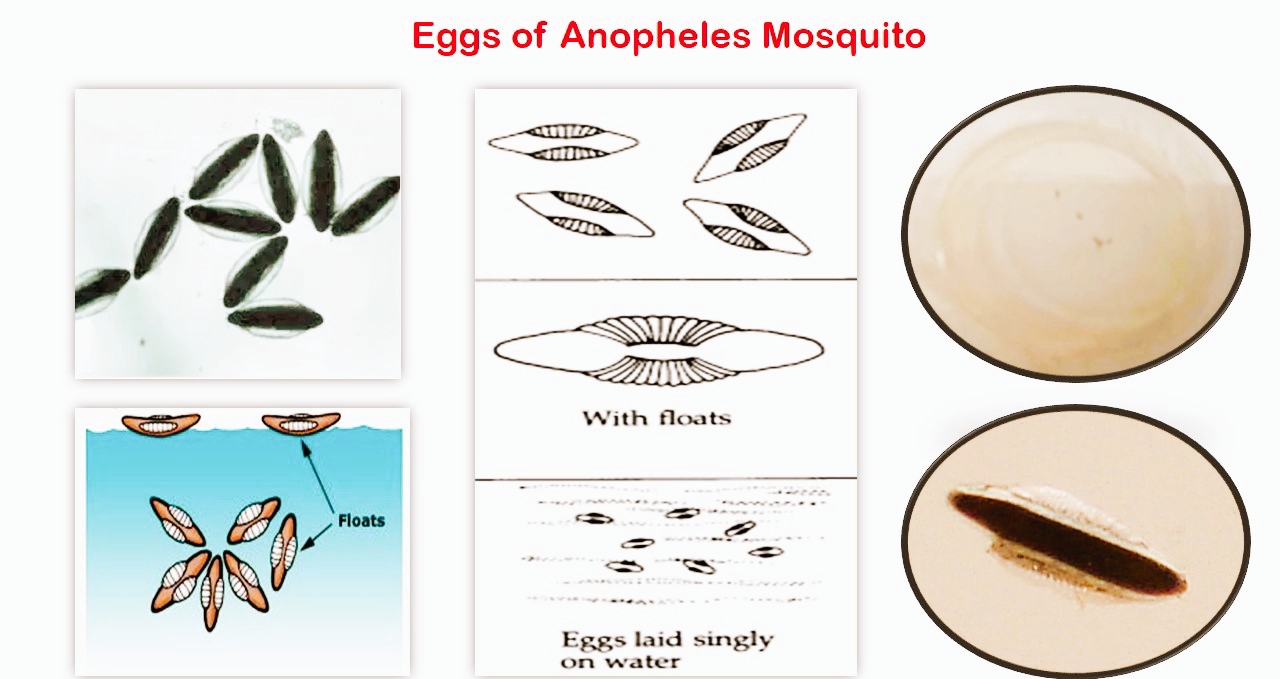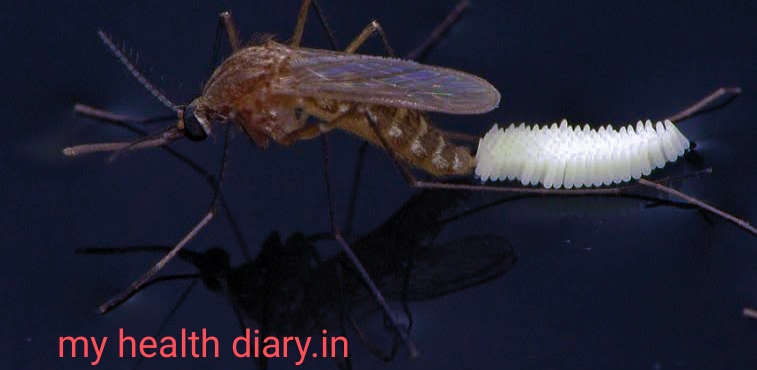A mosquito is one such insect. From which it acts as a carrier of many diseases. Mosquito-borne malaria, dengue, chikungunya, Zika, filariasis (elephant foot) Japanese encephalitis. It works as a carrier of diseases like Once mated, the mosquito lays eggs every 3 days until it lives. Which can lay 40 to 400 eggs. Which depends on the atmosphere and amount of water. But on average 100 to 150 eggs are laid by a female mosquito. Therefore, it is very important to understand the life cycle of mosquitoes to control mosquito-borne diseases.
The life cycle of all mosquitoes has four distinct stages.
1. Eggs
2. Pora (larvae)
3. Pupa (Cochato)
4. Mosquitoes
Eggs :- Each female mosquito mates only once during her lifetime, after which she does not need to mate again. And then it usually needs a blood meal to develop the eggs. A blood meal is taken two to three days before each egg laying arrangement. At the time of egg laying, about 100 to 150 eggs are laid on the surface of the water in the shape of a raft. Places of laying eggs are water filled in animal footprints, rain gutters, ditches, puddles, canals, rivers-lakes and rice water tanks. rooftops. scrap It is different for nymphs etc. The normal life span of a female mosquito is 3 to 4 weeks. A female mosquito only needs to mate once in her lifetime to lay eggs. After mating once, the sperm is stored in the spermatic organ of the female mosquito. After that, the mail mosquito dies. The female mosquito then repeatedly lays eggs through sperm in the collection of spermatozoa during her lifetime. The female mosquito lays eggs 2 days after taking a blood meal.
The eggs of each different genus of female mosquito are difficult to see with the naked eye in water. But from the shape of laying eggs of each female mosquito, we can know which are the eggs of the female genus. Now we will understand the eggs of each genus from area.
મચ્છરો નું જીવનચક્ર ની માહિતી ગુજરાતી માં વાંચવા અહીં ક્લિક કરો .
Eggs of Anopheles.
Female Anopheles mosquitoes prefer to lay their eggs in clean water. Anopheles eggs have floaters on both sides. Anopheles prefers to lay its eggs in shallow water and in water tanks along the banks of rivers. The eggs float on the surface of the water. Anopheles eggs look like loose eggs.
Aedes eggs.
Addis eggs lay eggs on the inner wall of the container. Addis eggs stick to the walls of the container like glue. Addis eggs look like black dirt. Addis eggs can survive for up to 8 months even after the water in the container dries up. It takes 7 to 10 days for an egg to develop into an adult mosquito. Aedes need only a small amount of water to lay their eggs. Addis egg bowl. Cup. the fountain tire container .barrel . vase. Coconut husks. aviary Aedes eggs are found everywhere. In particular, eggs of Aedes infected with Aedes eggs also become infected.
Eggs of Culex
Culex eggs stick to each other and appear raft-shaped. A female Culex clutches 100 to 300 eggs at a time. and forms a raft and floats on the surface of the water. Culex prefers to lay eggs in fresh and stagnant water. Horse hoofs. In unmaintained swimming pools. In pits made of animal dung. Culex prefers to lay eggs in small stagnant pits.
The number of eggs laid in each genus and species can range from 40 to 400. The amount of that water depends on the surrounding environment. It takes 7 to 10 days to develop from an egg to an adult mosquito. It also depends on the environment. The eggs of every mosquito are difficult to see with the naked eye.
2. Pora (larvae)
Pora (larvae):- After about 1 to 2 days, larvae form from the eggs. Anopheles mosquitoes swim parallel to the surface of the water. Because it needs air to breathe. The spores of Culex aedes mosquito lie diagonally from the surface of the water. It touches the surface and breathes with the psyllium tube. It absorbs food in the water. The spores are quickly swallowed from the water surface. comes back to. which is necessary for breathing. there are four stages or installations of pora. The four stages typically take 8-10 days to develop in subtropical water temperatures. Development takes longer in low temperature conditions. The larvae of each mosquito can be seen with the naked eye. And we can identify it based on its movement status.
Pora (larvae) of Anopheles .
The pores of Anopheles are found parallel to the surface of the water. Its movement is also seen parallel to water. It is the larva of Ano phyllis. His head remains horizontal for breathing.
Aedes na pora (larvae)
Aedes pods are fickle. It is seen hanging upside down in the water. They are slightly thinner than the pores of Culex. The larvae of Aedes are seen spiraling rapidly under the water with the slightest movement in the water. It is also sensitive to torch. Infected Aedes larvae are also infective.
Culex na pora (larvae)
Culex spores are found hanging upside down below the water surface. But they are not as fickle as the larvae of Addis. Moving in the water is seen slowly going under the water. It does not go down the spiral. It is slightly thicker than the pores of Aedes.It is the pores of Culex.
Pora from mosquito eggs remains in the form of pora for 3 to 4 days. Which depends on the environment. That time may be less. When in Pora form, it can be killed by Abate. It can be identified by the position of the pores. After 3 to 4 days, the mosquito transforms into a pupa.
3. Pupa (Cochato)
Cochato(Pupa): - Cochato is comma shaped and does not have mouthparts so it is non-feeding stage. As the pupa does not consume any food, it is not affected by Abate. Lives within the water surface.Floats when disturbed. The cochaeta stage lasts for two to three days. After that, the upper layer of the cochaeta cracks open. The adult mosquito then emerges from the cochaeta and lives on the surface of the water until it is able to fly.
4. Mosquitoes
After 2 to 3 days in the pupa (cochato) stage, the cochato breaks and a mosquito emerges from it. And it stays on the surface of the water until it is able to fly. And then the mosquito flies away.
Mating (breeding) occurs shortly after becoming an adult mosquito. Eggs develop after one or two blood meals. The complete egg-laying stage usually requires one blood meal. . The average lifespan of a mosquito is 20 to 25 days. by mosquitoes. Dengue Malaria Chikungunya. Zika. Filaria (elephant feet). Japanese encephalitis. West Nile. spread diseases like Mosquitoes cannot survive or function properly in temperatures below 10 degrees and above 50 degrees. 15 to 25 degrees temperature becomes more active for the growth and development of mosquitoes. Only the female mosquito takes a blood meal for the development of eggs. Male mosquitoes do not feed on blood. Female mosquitoes need blood for protein and iron for egg development and mammals for blood feeding. Birds. Reptiles Live both lives. It bites and gets blood food.
【 Biting Behavior 】
■ Anthropophagic ( Athropophagic ) = Mosquitoes that bite humans are called athropophagic.
■ zoophagic / zoophilic = mosquitoes that bite animals are called zoophilic.
■ endophagic = Mosquitoes that bite indoors are called endophagic mosquitoes.
■ Exophagic = mosquitoes that bite outside the house are called exophagic mosquitoes.
【 Behavior of Rest 】
■ endo philic (indo philic) = mosquitoes resting inside the house are called endo philic.
■ exo philic = mosquitoes resting outside the house are called exo philic.





















ટિપ્પણી પોસ્ટ કરો